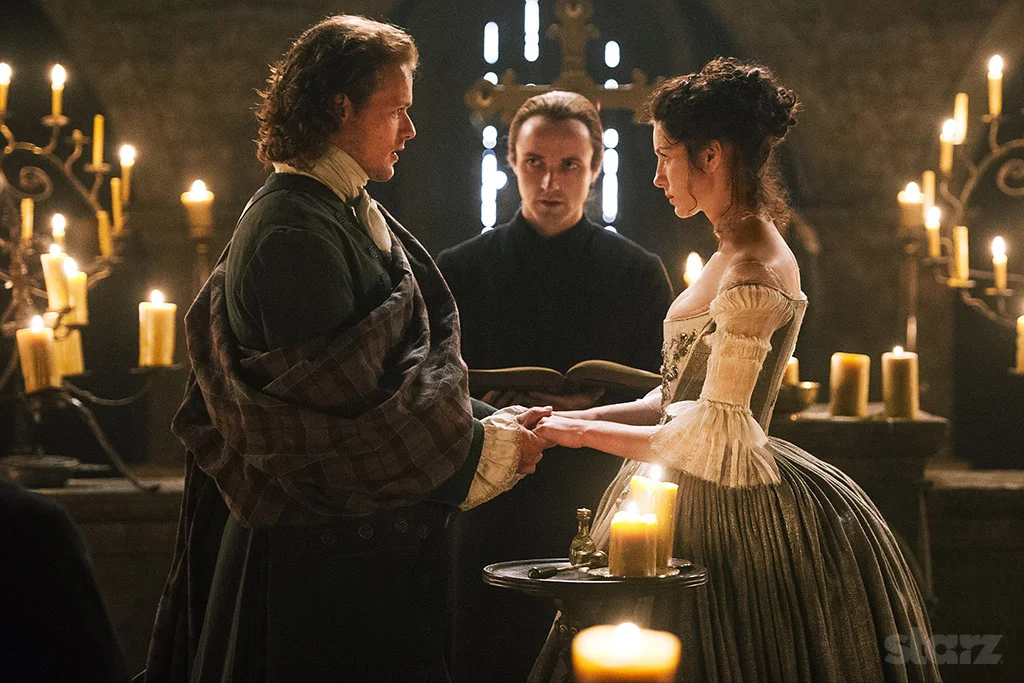Celtic & Scottish wedding traditions.
One style of wedding that continues to grow around the world is Celtic Weddings. Not only are many people looking deep into their family roots for wedding inspiration, but many have been moved by modern trends. One such recent trend stems from the hit television program OUTLANDER. With so much interest in Celtic and Scottish Wedding trends, we went to the experts in everything Celtic to ask a few questions - our friends at The Celtic Croft.
1. How prevalent are traditional Celtic and Scottish Weddings in the United States? What are some of the must-haves in a traditional Celtic Wedding?
There are not a lot of statistics on this but it is estimated to be in the 10,000 range annually. Traditional Weddings must include, full formal kilt dress for men and groomsmen, and usually a sash and garter matching the groom's tartan for the bride. This is the attire for a Celtic-themed wedding, however there are many traditions and they would vary in many ways if the wedding was Irish vs. Scottish, English, Manx, Welsh, or Cornish.
2. What recommendations do you have on traditional men’s dress? How about for the Bride?
Unless you only have one family tie to Scotland, know that you can wear any ancestral Tartan. In addition, if you're not sure about your lineage, there is a general Tartan that is very common; you won’t be left out and you'll still look great.
For the bride, there are many alternatives (if you are looking outside of the "White Dress Family") that can compliment the overall theme. Just ask the your friendly Celtic apparel outfitter for suggestions.
3. Let’s talk Kilts and Tartans. Explain the significance of the various Tartans. What does the modern Scottish Groom look for in appropriate attire?
Photo Credit: Fresh Photography
Tartan is a family registered plaid and every single one is different. Along with the Tartan, you want to ensure you have a full formal or dress attire which includes the Ghillie Brogues, hose, kilt pin, flashes, jacket (either Prince Charles or Argyle), kilt belt, Sgian Dubh, and shoulder fly plaid with brooch.
Celtic dress, specifically weddings, are preserved through formal dress and proper accessory attire. Where it with pride!
4. What is the significance of the horse shoe and the harvest knot?
Traditionally - Harvest Knot:
On a small farm, the Harvest Home feast would have been held in the kitchen. On larger holdings, the festivities took place in the barn - cleaned out and dressed up. Prominently displayed as part of the decor was the last sheaf. And, if it was held in a part of Ireland where a young colleen had tied the last sheaf. It was the custom, that she would be led out for the first dance by the Farmer or his eldest son.
Wedding Hair Style: Harvest Knot
It was at these gatherings that harvest knots were worn to show that the harvest was completed. Usually, they were made in two types: an elaborate braid with the corn ears still attached (which was worn by the women) and a less ornamental twist - although made with equal skill, (which was made for the men). Often, in modern times, you will find the Harvest Knot symbolically represented in bridal hair styling.
Traditionally - Horse shoe:
On the day of the wedding, it is not uncommon among Celtic brides to sew a horseshoe into the hem of a dress. Grandmother did it, and so did her mother. It is said that this act brings good luck. Horseshoes have always been associated with good luck, right? However, the real reason for this custom goes far beyond luck. It is part of an ancient belief, perhaps tracing as far back as the iron age. After the invention of the horseshoe and its association with luck, it became a natural thing to add into the very dress. And it also helps the dress hang properly. So, if your grandmother insists there be a horseshoe somewhere in your wedding attire, you will now have a clue why this may be beyond the merely obvious association with luck.
~ Reference: CelticJewelery.com
5. Where does the phrase “Tie the Knot” come from?
Photo by: Wikimedia Commons
Today, wedding couples around the world use a phrase that seems appropriate at every generation. Little do many know how ancient the symbolic meaning of the phrase "Tie the Knot" actually is. This comes from the old “hand fasting” ceremonies, which are still performed today in some pagan and christian traditions. The hands are tied with a ceremonial cloth OR the male's family tartan signifying their union. Quite moving when done correctly…hence ‘Tie the Knot’.
6. What sort of venue should traditional, Celtic engaged couples look for ?
Anywhere works. We have literally seen it all from a complete outdoor castle wedding in Europe, a Montana mountain range, to a simple church or post-modern art gallery. Kilts go everywhere with everything.
7. What other historical traditions have age-old meaning that are still very prevalent today?
Photo Credit: Fresh Photography
Rings and Bagpipes! Celtic Wedding rings are a basic expectation in Celtic Weddings of any kind. Most couples that are celebrating their heritage, do so openly with obvious Celtic rings. They often feature the symbolic harvest knot and other meaningful etchings. Often times, they don't have to be expensive either. The history of the Celtic wedding dates back to simpler times and today, we find that those that celebrate it, wish to maintain it. The most widely known traditional ring, worn even by teenagers and non-Celtic heritage folks is The Claddagh ring - one of the old traditions that's widely known. The traditional ring is usually given by young Irish men to their girlfriends as a gift; today known as a "promise ring". Sometimes it's inherited from a family member, but the ring takes part in wedding ceremonies, too.
Bagpipes are another tradition that often are a standard expectation at Celtic weddings. Though history will tell us that bagpipes were first seen as early as 1000 B.C., they have been a historic staple in the British, Canadian, New Zealand and Australian military. The first bagpipes to be well-attested to for Ireland were similar, if not identical, to the Highland pipes that are now played in Scotland. These are known as the "Great Irish Warpipes". In Irish and Scottish Gaelic, this instrument was called the píob mhór ("great pipe") - first appearing around the 18th century. Today bagpipes are becoming revitalized more and more every day.
8. Modern Twists: What do you see today that is inspired by modern culture in Celtic and Scottish Weddings?
There are two trends happening right now - "Grey Weddings" and "Ancient Weddings" (with a more 18th century feel). The main driving force behind both of these trends is the hit Starz television program Outlander. The Celtic Croft is an official licensee of Outlander kilts, apparel and accessories and the demand for these items has grown substantially.
Photo Credit: Starz "Outlander".
The Celtic Croft was recently featured on CBS Local in Minneapolis.
Getting Married? Inquire about your date today for Celtic Hair and Makeup.
Visit The Celtic Croft for all of your Celtic apparel, Kilts, and rental needs.









